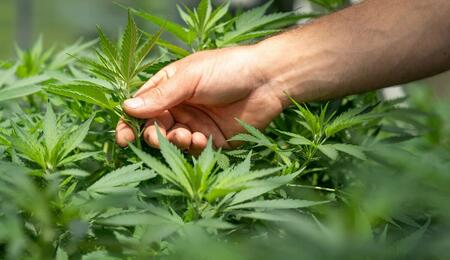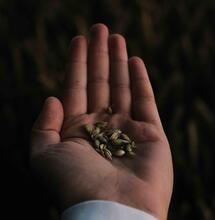Jorge Cervantes: ‘Now it’s for real, the free market has arrived!’

In the summer of 2006, we interviewed Jorge Cervantes, one of the greatest international cannabis experts and contributor to Soft Secrets. Five years later, he doesn't look a day younger, and still has the same enthusiasm for work and learning. It is always a great pleasure to speak with Jorge Cervantes, not only for his knowledge of the cannabis world, but also for his depth as a person.
Soft Secrets: What have you been doing since our last interview?
Jorge Cervantes: In 2005, I started writing for several magazines; more than 20, actually, most of them new. Biblia Nueva was published in 2006, followed by my first video. 2006 was an important year; things started changing, and - thanks to our success - I realised how central YouTube would become. Many users shared the video right away, which was great publicity for us. In 2007, the Indoor Bible was published here in translation, and an edition in French was published, as well, and I made my second video. The key was being in Spain in that period, because a lot more was going on in Spain than in the United States - it was during the George Bush administration, when you couldn't do much of anything. Of course, medical laws already existed in several states, but people were afraid, and so things progressed slowly. In the meantime, I had no trouble working in Europe, in countries such as Spain, Holland and Sweden. It was a constant learning experience; we were quite free to visit fields and gardens, there was not much control. I worked a lot, and worked hard...
How old are you? That is quite a work rhythm to maintain...
I'm 57 years old. Most people my age don't work as much as I do, it's true, but I am surrounded by young people all day, and they inspire me. Young people have a lot of strength and energy.
What have you learned about outdoor growing in the past few years?
That both the ground and the water are terrible in Spain. It is expensive to improve the ground, there is a lot of clay and drainage is very poor, not to mention the dry climate throughout most of the country. The water has a high pH level, and there is too much wind, which makes cultivation more difficult. Most outdoor growers don't improve the ground, but it needs to be done. When you use flowerpots, you need to know how to care for them, and make sure they don't get too warm. Soil is also different from place to place; for example, in the Cantabrian area it is much better than in other areas.
What do you recommend doing to improve the ground?
You can carry out analyses to determine what is missing, but the most important thing is to add organic matter - manure or any compost you can find. Compost and more compost. The main thing is to find life and ensure that it can grow and develop in the ground. This is super important.
For example, I recently wrote about a group of young people who grow giant plants. Well, all they add during the growing process is a couple of handfuls of bat guano; the rest is due to the soil's previous enrichment.
You have to try and make life grow in the ground, and help it develop. The main thing is to infuse life into the compost and the soil and maintain it for the whole year, because it can die very easily. When you grow organically, you must be careful never to use chemicals, because they destroy all life in the soil, and it will take a very long time to reach it again. People rely on the products they buy; these products are useful, but not much.
The main thing is to know your ground well. A good idea is to start a garden with other types of plants, which you can use as an example for your own garden, If you plant marijuana in one plot and lettuce, tomatoes and peppers in another, these other plants can warn you about any problems there might be before they affect your marijuana plants. You need to use mulch and keep the soil covered with materials, in order to protect the roots and the ground itself.
You became famous with your lessons on indoor growing, but now you have become very interested in outdoor growing...
I actually prefer outdoor growing to indoor growing, it's the great thing that I learned in Spain. If it weren't for the law, everyone would cultivate outdoors - it would be great. When I began, 30 years ago, everyone told me: "Weed planted indoors won't take." Now it's the opposite, people say that indoor weed is better, that it takes better. But actually, both types can be equally good.
Why did you return to the United States?
I'd spent ten years far from my family, and my children are older now. So, mainly for family reasons. There were also business reasons, of course, especially since Bush left. But in first, second and third place is the fact that I wanted to be with my family; other reasons aren't as important. If it hadn't been for my family, I would have stayed in Spain - I like it here. Also, I can help with the crisis; politicians really need help.
Did you notice many changes when you returned to the United States?
Everything has changed in the States; it feels like a different country. When I left last time, I lived in fear of persecution... and it was certainly not possible to buy marijuana. When I returned, it had become possible. Buying marijuana legally in the United States was a very emotional moment for me; I didn't realise how it would feel until I left the shop with my newly-purchased bag; I started trembling from head to foot. It had been illegal my whole life, but not anymore. It was amazing to be able to purchase marijuana with a receipt and everything, a tax-deductible receipt, no less. Buying medical cannabis there for the first time was very, very exciting and moving.
All of a sudden, I could plant seeds in my own house. Before, there was a law stating that if you used your home for illegal drug activity, then the house could be seized. Any grower lived in fear of losing their home. Now that law is no longer valid. I can plant my medical marijuana without worrying about losing my house. This represents a great change. However, the former law is still valid in several states; your house can be seized and the money goes to the precinct that catches you. It's crazy.
Have you been planting crops there this whole time?
Of course, of course. My wife and I both have a licence for medical use. We began feeling ill as soon as we entered the country, it was a disease, and we had to request a licence to be able to grow and purchase medical marijuana.
I must confess that, the first year, I was still afraid to return. You know what they tell you, what the laws say, you know what you see on TV, what you read in the papers, you know what you buy and that you possess the card... but it's different once you put your own neck on the line, you're still afraid. Many of our friends have ended up in prison and lost their house because of their crops. It took me several months before I began planting my seeds, I kept making different excuses; I didn't think it would be like that for me, but it was. After working illegally for years, it's hard to change gears, even when you have the opportunity. It was hard for me. Once you change, though, it's a whole different story. Now I am still very attached to marijuana, but I also tend tomatoes - they're all plants, really. That's the fun of this job: you can grow marijuana as if it were any other plant.
How many marijuana plants can you grow?
Where I live, you can have up to six plants per person, so my wife and I can grow twelve plants, total.
Does the number vary from place to place?
Yes, the number of plants isn't clearly defined; the amount depends on where you live. In some places, your licence allows you to have six plants, in others you can actually plant up to 99. It depends on several factors, and even law enforcement itself isn't sure. One of the main things is to never exceed those 99 plants, because then it becomes a federal crime, which is very dangerous.
What's going on with the US market? How has legalization affected it?
There are large fields and plantations. It's quite similar to Switzerland, where they would also plant large fields and greenhouses. In some places, harvests are huge, and it takes a lot of work to take care of everything and harvest in time.
I am noticing a lot of difference in prices. For example: two seasons ago, a half kilo cost between $ 3,000 and $4,000; now it costs between $2,000 and $3,000. And prices will come down, too; several people are saving their weed, because they don't want to just sell it and are willing to wait to sell it for six months or more - but this means that, when they place it on the market, prices will go down.
Will this change growing habits in general?
Indubitably. Before, you would invest a lot of money in a single plant, but things are changing. A plant that earned you $1,000 two years ago now earns you $600, but two years from now, the same plant will be worth $200 dollars for you. This makes it necessary to be much more efficient in planting. Squandering large amounts on products and fertilizers, just for the sake of it, is no longer an option. Now we're talking seriously; the free market has arrived.
I have been studying the costs of producing these large pants, and they around 20%-30% of the final price. This is too high; costs should actually be around 1%-5%. This is the most important change for new and future sellers.
The change towards outdoor growing and larger plants is very important, because now growers can obtain much more than before; a good crop can yield a ton of weed. Of course, that's not enough; afterwards it must be sold, and now everyone and their neighbour has a ton to sell with each crop. A lot of weed! And what are we going to do with it all? The first step is exporting it to a place with money; this is a very common practice, it happens in most markets. Also, the price will decrease, and the stupidity will end.
Lots of people consider this unfair; they would prefer a more controlled legalization, in order to maintain more stability in the market.
These people also think that they have earned their place, if it becomes legal. They believe that they have learned and struggled a lot in the past 20 or 30 years and so they deserve a place on the market, whereas the "newbies", the new growers who are showing up as the laws are changing, don't deserve what's being given to them.
That is a ridiculous point of view! Why should anyone have "special rights"? Many people think "I know all this, I learned it all - by myself, nobody helped me." It's all "me, me, me" for them; but too much ego can blind you. We aren't special; nobody learns alone, nobody knows everything, nobody is God. The real market is on its way; focus on that, and you'll be ready for it. Leave the talk to the others, because that's all they'll be doing.
So, the old prices are too high; prices must be lowered. Nobody wants to, but it will soon be necessary. Things are going to change very rapidly, and the people who realise this are the ones who will come out on top. It's going to happen and it needs to happen. The market will become cleaner and clearer; the public will choose growers who provide the best quality for the lowest price.
The changes you see are aimed at a better efficiency; but would you summarise how cultivation was in California during the years of expensive weed, when there was no shortage of resources, for us?
It's very interesting, actually. What they do is obtain several cards or licences and then have a large farm for growing. Most of the ground is in bad shape; some growers dig wide, deep holes to make it easier, but there is a limit to the holes you can dig. Others use grow bags and flexible flowerpots (called "smart pots"). They use 200 gallon bags (around 910 litres): They buy soil or create it to fill the flowerpots. The large "smart pot" alone costs $50, not to mention the amount of soil you need to add.
In California, I've met people who were spending between $5,000 and $10,000 in fertilizers for their crops, when $1,000-$2,000 - maximum - would be a fair price. But soon, these farms will begin implementing the normal procedures that the Department of Agriculture could recommend.
You need to place lights on the side, to avoid premature flowering, because these seeds are planted outdoors around March and are harvested at the end of October - they take around eight months to bloom. It is best to use low-consumption fluorescent lights, but remember to break the light cycle to avoid premature flowering. These lights are inexpensive but, for 99 plants, you need to use 99 light bulbs, with the corresponding cables and equipment.
You must add an irrigation system separately - pipes, droppers, tank and water pump. Water also costs money, not to mention the time it takes to maintain it; you basically have to pay yourself. All of this requires labour, expense and maintenance. You need to know how to introduce these techniques correctly - it will simplify your work and, in the long run, be less expensive, rather than complicating things.
So you see great changes in growing styles?
You need to follow the market and be realistic; realise what the market requires, because that's all there is. New products are well and good, but remember that, for example, a large nursery for normal plants won't use many products. The conventional agricultural market is not very sophisticated. There is an overdose of products; we use much more than we need, too much fertiliser, for example. Lots of people buy without having a clear idea of what they need. That attitude must change, these growers need to become more efficient.
As you tell it, you're not the only one to have changed gears: many other growers have also lost their fear.
That goes without saying. Let me tell you about a friend of mine, for example. He's Mexican, about my age, a great guy. Before, to reach his field, he had to climb up to it with an engine, hanging off two wheels attached to a cable. Then he had to use a ladder to get back down. Now he lives peacefully in the area nearby, he got a bulldozer to level out the field and uses huge grow bags. In other words, he's got it all clear.
Tell us some more of your outdoor California colleagues' secrets.
One very common practice is to cultivate bit by bit. They carry out two or three cuts for each plant - sometimes even four, with plants like Mr. Nice. As the plant grows, they add wire netting to hold it, usually two layers. They start cutting the tips of the branches over the netting, which is already one or two kilos. Then the remove the top layer of netting and wait a couple of weeks. These buds receive more light and grow enormously, which leads to harvesting an extra kilo or two. Then they remove the lower netting and wait another week, when they collect the last kilo.
Usually, planters stay and smoke these last buds, which are the best ones, with the most resin. A field that yields 120 can yield 200 ponds with this technique - in other words, 40% increase in production. That's not much if you just have a few plants, but a 40% increase in production - not to mention a much more conveniently distributed harvest - makes a big difference. This is an excellent technique for distributing labour and increasing production.
Will Spain be seeing the same decrease in prices?
Spain is beginning to show some symptoms of overproduction, so prices will probably go down a little, but not as much as in the United States, because the previous increase wasn't as high. Here in Spain, hashish has always set the market's reference price. Hashish is cheap, between two to six euro per gram, depending on the quality, and this keeps the price of all weed low. That's the mechanism that regulates this market. Also, growers have always been quite efficient here, without spending large sums on unnecessary problems.
Yesterday, Jaime - breeder of Resin Seeds, mentioned to me his impression that plants with a high CBD level are much more resistant to problems such as infestations. Other people have said that the CBD level is overestimated, that it's not too important. What do you think?
It is a fact that CBD works very well against inflammation; it also lowers the stoned effect, which most medical users don't enjoy. Jaime has done a really interesting job and his plants are very high in CBD; they also show a 1-to-1 ratio of THC and CBD. Anything he tells you is a fact; not many other people have observed these aspects before now. It's important to invest in investigating several things, studying everything!
What are your next projects?
First of all, I plan to make several videos. I have about five hours of edited material, but would like to double those hours by the end of the year. Videos represent the future, we are always filming, indoors and outdoors, in Spain and in California. I want to have more than 10 video hours ready by the end of the year, I will be presenting my own channel: www.jorgecervantes.tv. You can also find us on YouTube; our video with the big plants is very popular, it still receives more than 875 hits a day, which is impressive, considering how long ago we posted it. All you have to do to see our videos on YouTube is plug in "Jorge Cervantes".
Several countries don't belong to the "cannabis circle", for several reasons: because of their laws, or because it's not profitable for them to have or import magazines, but the internet is like an open door that will never close. Videos are easy to translate or to understand; in other words, more people have access to information and more people are starting to grow - it's phenomenal.
This is the outdoor special edition; we would like some more advice on outdoor growing in Spain.
If you want to grow big plants outdoors, you need to begin germinating; the plants will already be good-sized when you place them in the holes. Artificial light is necessary to avoid the plants blooming in the spring, which is the wrong moment.
You need to prepare the soil half a metre deep; I used to think a deeper hole was necessary, but now I've realised that half a metre deep and one metre wide are sufficient.
You are a member of several California Cannabis Clubs; how about some advice to people in Spain who would like to start a club in their country.
Each country or state has its own laws, which you need to know so you can push them to the limit - but you need to be careful to realise what that limit is, because it's often difficult to determine. One good thing is that legal action is quite expensive; the ability to negotiate with politicians and changes in government is also important. Money is a card that we need to know how to play. Times are better than ever for us; the economy crisis means there isn't enough money to confront everyone, so that's why we should be planting more and more.
I also have a request: I would like to be able to have access to the Spanish clubs with my US membership cards.
Some advice for an outdoor grower who would create a large plantation for a club?
More water. A very typical problem is that the plants are thirsty and require more water. Automated irrigation is the best choice if you have a large piece of land. Of course, you have to add mulch and consult with neighbouring farmers. And make sure the wind doesn't dehydrate your crop.
Would you like to add anything, to round out the interview?
Just keep planting; plant more and more and more. That's what has to be done.







